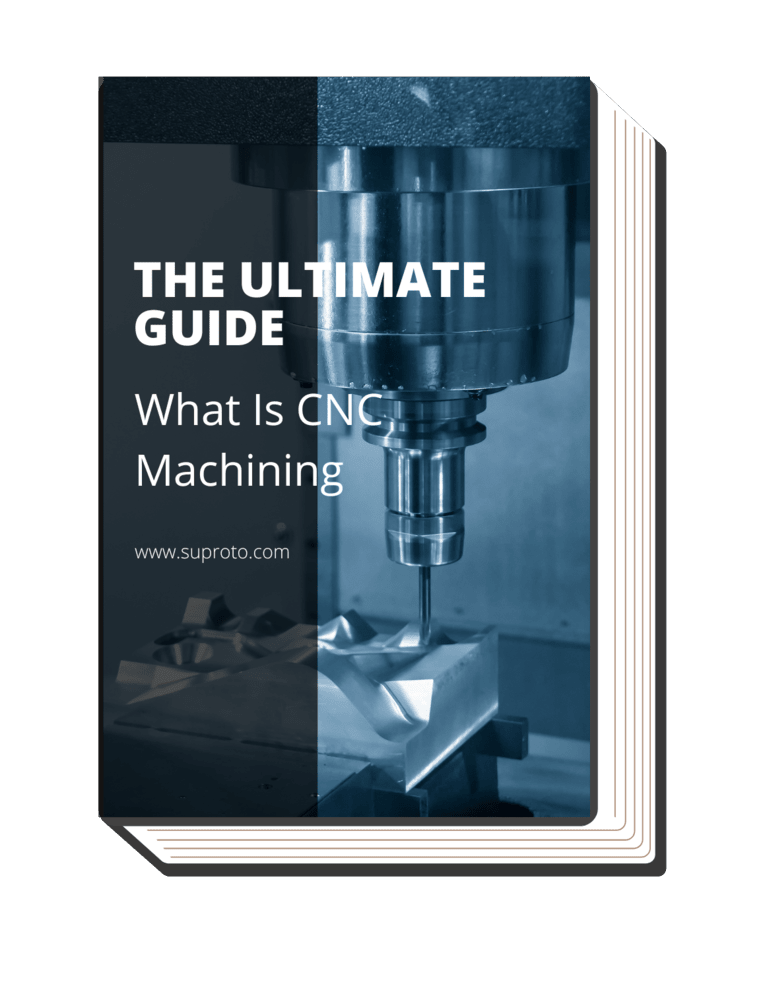Ever felt your heart sink because your meticulously crafted product is marred by minor imperfections, threatening its performance and lifespan? Surface grinding could be your winning ticket to eradicate these flaws, pushing your business to new peaks of success.
Surface grinding, a method renowned for eliminating imperfections, enhances the quality and durability of your products. The result? Boosted customer satisfaction and a flourishing bottom line. In this guide, we’ll explore surface grinding’s astonishing benefits, and demonstrate how mastering this technique can be a game-changer for your business.
Ready to delve deep into the world of surface grinding and tap into its potential? Read on and let’s transform your business together.
1. Detailed Overview of Surface Grinding Machine
The surface grinding machine is a crucial tool used to create smooth finishes on flat surfaces, enhancing both the aesthetic and functional qualities of a part. Now, I can almost hear you thinking, how does it achieve this? Citing a resource from Pressbooks.pub, it is a very precise tool that uses a stationary, abrasive, rotating wheel to shave or finish a metallic surface that is held in place by a vise.
The feed rate is a critical factor to consider in surface grinding, as it determines the speed at which the grinding wheel traverses the workpiece. From my experience, mastering the feed rate has proven to be the differentiating factor between a satisfactory job and achieving truly outstanding results.
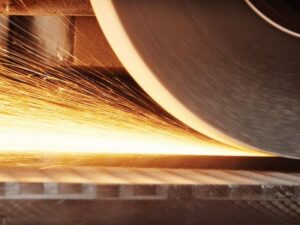
2. Brief History of Surface Grinding
Surface grinding, a vital process in the realm of manufacturing, has an interesting history dating back to the 19th century. The concept of surface grinding originated as a means to ensure the precision and smoothness of parts and components, primarily in the machine tool industry. Speaking of surface grinding, let’s delve into its brief history:
Early Inception
In the early 19th century, surface grinding was a manual process where parts were shaped by hand. This process often led to inconsistent results due to human errors. We must remember that at this time, precision was much harder to achieve, limiting the applications of surface grinding. For example, if the operator was not careful with the hand feed wheel, it could lead to an uneven finish on the workpiece.
Innovations in Abrasive Materials
The advent of new abrasive materials such as silicon carbide and synthetic diamond brought a significant shift in surface grinding. Here’s the interesting part: the hardness and durability of these materials greatly enhanced precision, allowing more complex and precise grinding tasks to be accomplished. The advent of these new materials revolutionized the process and expanded what we could accomplish with surface grinding.
Shift Towards Automation
The mid-20th century marked the advent of automated surface grinding machines, a significant leap that promised heightened precision and efficiency. This shift was driven by the growing demand for high-quality, consistent components, as minor variations could affect product performance. From my years of experience in this industry, these advancements have indeed reshaped manufacturing, boosting efficiency and quality.
3. Types of Surface Grinding
Imagine the world of manufacturing as a vibrant tapestry, with surface grinding as one of its essential threads. This versatile technique comes in different types, each tailored to specific needs. Now, let’s explore the remarkable potential of the diverse surface grinding types below:
Horizontal Spindle
The horizontal spindle grinder features a horizontally placed spindle with the grinding wheel facing downwards. It is highly favored for high-precision surface grinding due to its efficient material removal and ability to achieve fine surface finishes. Manufacturers, like Suprotos, rely on these machines to meet stringent quality requirements and deliver exceptional precision in surface grinding operations.
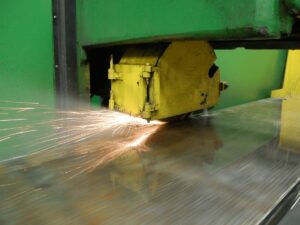
Vertical Spindle
Unlike horizontal spindle grinders, vertical spindle grinders boast a vertically oriented grinding wheel. These machines are typically preferred for intricate jobs such as grinding profiles or molds, thanks to their adeptness at achieving detail-oriented precision. Their unique design facilitates an unobstructed view of the workpiece, making them especially suitable for detailed operations.
Single Disc Grinders
Single-disc grinders utilize one disc for operations, making them effective for large surface grinding in just one pass. And now, you’re thinking, how efficient can they be? I assure you, they are particularly effective for applications requiring the grinding of large surfaces in a single pass. They efficiently provide quick, uniform grinding, vital in various manufacturing contexts.

Double-Disc Grinders
In contrast to single-disc grinders, double-disc grinders utilize two parallel grinding discs to simultaneously grind opposite sides of a workpiece. And the best part is, this leads to highly precise and efficient operations, making double-disc grinders suitable for mass production. It’s fascinating to consider how the right choice of grinder type can optimize operations.
4. Materials Suitable for Surface Grinding
Surface grinding requires selecting the appropriate materials to achieve optimal results. Certain materials are better suited for this process due to their hardness and compatibility with grinding tools. Below, we will explore the suitable materials and the tools used:
Metals and Alloys
Metals and alloys are often subjected to surface grinding to improve surface finish or achieve specific shapes and dimensions. Now, this is important… The selection of the appropriate grinding wheel can significantly affect the final surface finish on metal and alloy components. With the following materials below, it’s time to unlock the full potential of this remarkable process and take your manufacturing endeavors to new heights.
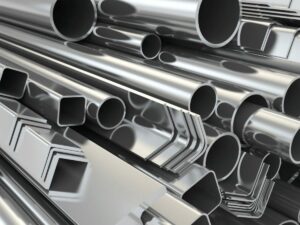
Ceramics and Glass
Ceramics and glass, despite being brittle and non-metallic, are commonly processed using surface grinding. Despite their inherent hardness, these materials can be precision-ground to achieve highly smooth and accurate surfaces. Grinding ceramics and glass enables precise finishing and shaping for optimal performance in various industries.
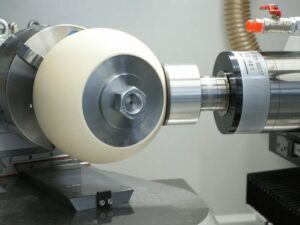
Polymers and Composite Materials
Despite being softer and more pliable than metals or ceramics, polymers, and composite materials can also be ground. Here’s the interesting part… The process often requires specialized grinding techniques to prevent melting or deformation. This just goes to show how versatile surface grinding can be when tailored to the right material.
5. Surface Grinding Processes
From selecting the right grinding wheel to adjusting the workpiece’s orientation, each step is tailored to the task at hand, achieving a level of precision unparalleled in the manufacturing industry. Below are the tools and the step-by-step process of surface grinding:
Step #1 Preparing the Workpiece
During the preliminary stage of surface grinding, meticulous cleaning of the workpiece and its secure placement on the grinding machine is essential to ensure stable operation. For instance, the selection of an appropriate workpiece holder plays a crucial role in maintaining the accuracy and efficiency of the grinding process.
Step #2 Selecting the Grinding Wheel
The grinding wheel’s choice largely depends on the workpiece material. Now, this is important… The correct selection of grinding wheel material, grain size, and bonding can significantly impact the process’s success. This level of precision in choosing the right grinding wheel ensures optimal performance, efficiency, and the desired quality of the final surface.
Step #3 Setting Up the Surface Grinding Machine
Before grinding, the machine needs to be set up correctly, ensuring that the grinding wheel and workpiece are appropriately aligned. This meticulous step is crucial as it directly impacts the final quality of the product. By carefully aligning the grinding wheel and workpiece, manufacturers can optimize the grinding process, resulting in superior product quality and customer satisfaction.
Step #4 Adjusting the Grinding Parameters
These critical factors encompass the speed of the grinding wheel, the depth of cut, and the feed rate. Here’s the bottom line… The speed of the grinding wheel determines the material removal rate, while the depth of the cut controls the amount of material removed in each pass. Mastering these factors is key to achieving optimal results in surface grinding operations.
Step #5 Executing the Grinding Operation
The culmination of the surface grinding process lies in the final step: the actual grinding process, where the grinding wheel skillfully engages with the workpiece, orchestrating the creation of the desired surface finish and shape. This stage demonstrates the expertise and precision of both the machine and skilled operators, resulting in exceptional results that meet project specifications.
6. Surface Grinding Techniques
Surface grinding techniques involve the process of refining and smoothing the surface of a workpiece using an abrasive wheel. This method is commonly used in manufacturing and metalworking industries to achieve precise flatness and smoothness. Outlined below are the techniques used in surface grinding:
Blanchard Grinding
Known for its speed and efficiency, Blanchard grinding uses a rotary surface grinder to remove large amounts of material quickly. This technique is often used for rough machining before another method is applied for the final finish. For example, the amount of material removal can impact the grinding wheel’s selection and the machine’s operating parameters in Blanchard grinding.

Precision Flat Grinding
This technique, as the name suggests, guarantees exceptional precision and flatness, making it a go-to method when absolute precision is non-negotiable. Precision flat grinding employs a surface grinder with a magnetic chuck for secure workpiece fixation and accurate results. Amazing, isn’t it? This technique ensures precise, flat components that meet stringent tolerance requirements.
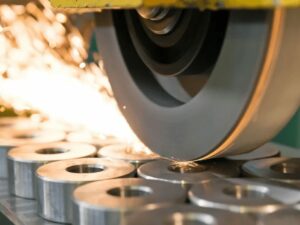
Creep-Feed Grinding
Creep-feed grinding, unlike traditional methods, removes material in a single, slow pass, minimizing thermal damage and improving surface finish. This approach is highly suitable for complex or intricate profiles. You won’t believe what we discovered. It’s fascinating to see how adjusting the grinding approach can have a profound impact on the final result, delivering superior precision and surface quality to our valued customers.
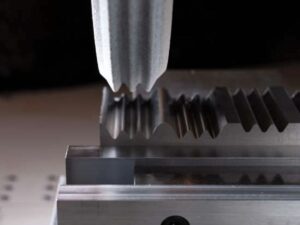
Centerless Grinding
Centerless grinding is a technique that holds the workpiece in place by the pressure of the grinding wheel and a work blade, rather than by a chuck or center. According to Fortune Business Insight, the global grinding machines market size was USD 4.72 billion in 2018 and is projected to reach USD 6.73 billion by 2026, exhibiting a CAGR of 4.6% during the forecast period.
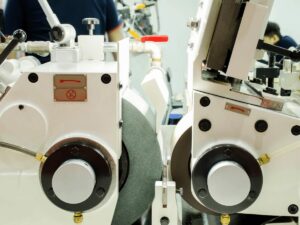
7. Surface Grinding Applications
The applications of this unique process are far-reaching, extending to various industries and aspects of everyday life. From the sleekness of your smartphone to the efficiency of your car’s engine, it’s all made possible through a set of intricate techniques. Here are the different surface grinding applications:
Automotive Industry
Surface grinding naturally plays a significant role in the automotive industry, where it is extensively employed by manufacturers like Suprotos for creating precise shapes and finishing various parts, including engine components, brake pads, and gears. Achieving the right surface roughness is critical in engine components as it directly impacts the optimal functioning and performance of the vehicle.
Aerospace Industry
In the manufacturing industry, precision and reliability are of paramount importance. Surface grinding plays a vital role in achieving the required tolerances and surface finish in critical components such as turbine blades and other intricate parts. Here’s what we found instead, employing precise grinding techniques and advanced surface grinding machines enables manufacturers to meet stringent quality standards across industries.
The following table illustrates the diverse applications of surface grinding in the aerospace industry, emphasizing its vital role in achieving precision, reliability, and meeting stringent quality standards for critical components and parts.
| Application |
Importance |
| Turbine blades |
Critical components requiring precise tolerances and surface finish. |
| Engine components |
Ensures precise dimensions and smooth surfaces for optimal performance and reliability. |
| Landing gear parts |
Achieves required tolerances for safe and efficient operation. |
| Aerospace structural components |
Enables accurate fitting and assembly of structural parts for enhanced safety and durability. |
| Avionics and electronics components |
Ensures precise dimensions for proper functioning and reliability. |
| Propulsion system parts |
Achieves high-quality surfaces for efficient power generation. |
| Wing and airframe components |
Enables precise fitting and alignment for optimal aerodynamics and structural integrity. |
| Heat shields and thermal protection |
Provides smooth and uniform surfaces for effective heat dissipation and protection. |
| Satellite and space exploration parts |
Precision grinding ensures accuracy and reliability for critical space applications. |
Electronics Manufacturing
Surface grinding is utilized to shape and finish electronic components, including semiconductor wafers, where it all boils down to this, high precision is of utmost importance. Precision grinding is essential for electronic miniaturization. This process ensures precise dimensions for the seamless integration of electronic components into advanced devices.
Medical Device Manufacturing
By leveraging the precision and accuracy of surface grinding techniques, manufacturers achieve the exact dimensions and impeccable surface finish required for these life-saving devices, guaranteeing optimal functionality, compatibility, and patient well-being. The meticulous craftsmanship involved in surface grinding plays a vital role in advancing healthcare and contributing to the success of complex medical procedures.
8. Safety Measures in Surface Grinding
Surface grinding is a machining process that involves removing material from a workpiece using a rotating abrasive wheel. To ensure the safety of operators and minimize the risk of accidents, various safety measures should be followed. Outlined below are the safety precautions to take into account during surface grinding:
Essential Personal Protective Equipment (PPE)
Operators must prioritize their safety by wearing appropriate personal protective equipment (PPE), including safety glasses, gloves, and protective clothing. This ensures effective protection against potential injuries caused by sparks, metal shards, and dust generated during surface grinding operations. Safety is paramount in the workplace, and proper PPE minimizes accidents and ensures operator well-being.
Operational Safety Guidelines
Safety guidelines encompass rules for machine use, such as keeping the work area clean and ensuring the grinding wheel is correctly fitted and not damaged. Each machine should have an emergency stop button readily accessible in case of any sudden mishaps. Remember, following safety guidelines isn’t merely a regulatory demand; it is fundamental for the welfare of the workforce, whether they are involved in grinding processes or CNC milling.
Machine Maintenance for Safety
Regular maintenance is essential to ensure the efficient and safe operation of machines. This involves inspections, part replacements, and cleanliness to maintain performance and prolong machine lifespan. But guess what I realized just in the nick of time. Regular maintenance maximizes productivity, minimizes downtime, and ensures a safe working environment for uninterrupted production.
Conclusion
In conclusion, surface grinding is a vital manufacturing process used across various industries for precise machining, offering excellent accuracy and versatility in material usage. But wait, there’s more. Ensuring efficient and safe surface grinding involves understanding its history, types, techniques, and stringent adherence to safety protocols. When done right, the impact on your production line can be transformative.
If you’re considering the implementation or upgrade of surface grinding in your operation, our expert team at Suprotos is ready to guide you. Contact us today to explore how we can help enhance your manufacturing process with the power of surface grinding.









